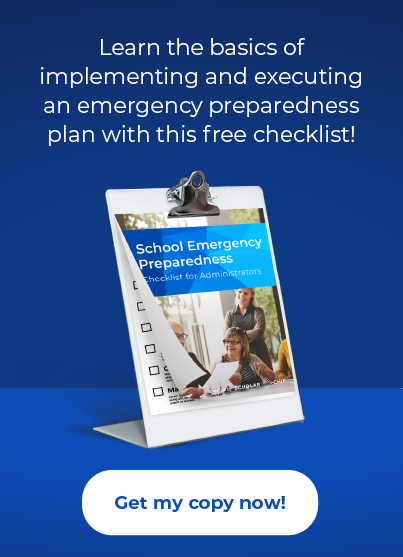Consider this scenario: You open your school for the new school year, taking as many precautions as possible. Students’ temperatures are checked when they come through the door. Space is used creatively so students can stay six feet apart from each other and from teachers at all times.
However, one student comes to school and starts exhibiting symptoms of COVID-19. Or perhaps, transmission of COVID-19 levels start rising in your area.
How can you prepare your school for this kind of emergency?
There is considerable ambiguity surrounding the reopening of K-12 schools in the United States. Even with exhaustive protections, it is imperative to plan for the likelihood that someone on your campus—students, faculty, or staff—will be diagnosed with COVID-19. Furthermore, it is possible that an increased surge in transmissions could happen in your area. So, your back to school emergency preparedness plan needs to consider ways to clear your campus as quickly as possible.
Let’s discuss four ways to adapt your back to school emergency preparedness plan to reflect our new COVID-19 reality.
Add a COVID-19 response to your emergency operations plan
In preparation for the likelihood that someone on your campus may fall ill with COVID-19, the CDC recommends updating your emergency preparedness plan to include this particular scenario. In coordination with your local public health organization, you should decide how to execute quick dismissals from school in case of emergencies.
You should also use their directives to consider how to teach students to be aware of their own health and report their illness to adults. This way, students can be active participants in stopping the spread of disease.
Create quick dismissal plans
If a student or staff person is sick, they may recognize that they’re not feeling well while on campus. After isolating this person, you’ll want to dismiss your students as quickly as possible.
To make sure early dismissal can happen smoothly, you’ll need to prepare beforehand.
The first step is communicating with parents before an emergency situation about how their students will be returned home (on buses) or how they should be prepared to pick up their children early from school.
Next, you need to make sure that you can easily find out where students, faculty, staff, and visitors are on campus. ScholarChip offers several tools that can simplify this tracking. First, our Visitor Management kiosks keep tabs on everyone who enters and leaves the campus. This is important not only for efficient dismissals but also for ensuring effective contact tracing.
You can also equip students with One Cards that will simplify tracking their attendance. Students have unique identifiers in the cards and simply tap them on Secure Access Portals to enter and exit campus doors. Since many back-to-school plans suggest staggering attendance times or creating hybrid in-person learning, knowing when and where students are is particularly important.
With these procedures in place, parents will be prepared to pick up or meet their children in the event of an emergency dismissal. School officials will also be better equipped to quickly clear out campuses.
Use contact tracing to minimize impact
If you’re notified about a sick student or staff member, your objective is to minimize the impact of that illness. The best way to do this is to trace where the sick person traveled on your campus and with whom they were in contact. Then, your contact tracing team should tell those who were in sustained, close contact with said individual that they have an increased risk for contracting COVID-19.
One of the critical factors of an effective contact tracing plan is using technology to simplify tracking contacts. For instance, if two students tapped into a classroom using their One Cards and one of those students was diagnosed with COVID-19, the contact tracing team would know to contact the other student in the room. While interviewing infected individuals is an effective tactic, using attendance-tracking technology uncomplicates this process.
Consider how long you will extend the dismissal
There are many reasons that you could lengthen your school dismissal. A scenario could include increases in COVID-19 transmission in your area that would make in-person instruction impossible. If a student or staff member is diagnosed too, it’s likely that you’ll choose to extend this dismissal over the long term.
In preparation for these dismissals, consider the factors that would necessitate a school closure, as well as think about how long a dismissal would last. You also want to consider your communication strategies with students, faculty, and staff. You’ll need to develop plans for virtual learning, which allow for long-term school closures, and for providing necessary services, like free breakfast and lunch programs for low-income students.
During this pandemic, administrators have been tasked with making unprecedented decisions. As there are no guarantees about the length or severity of this pandemic, your most effective strategies will always center on developing the most robust back to school emergency preparedness plan possible.
Interested in exploring more ideas for developing a new normal in our schools? Read more about our COVID-19 school preparations here.
ScholarChip offers holistic school safety services aligned with CDC guidelines to help schools reopen amidst growing health concerns. Through our advanced technology, built and designed for the K-12 environment, schools can identify risks and mitigate the spread of infection. Our solutions include fever screening, visitor surveys, symptom and vaccine tracking, in-school contact tracing, alerts and notifications. Learn more about our advanced COVID-19 solutions or request a reopening strategy session today!


